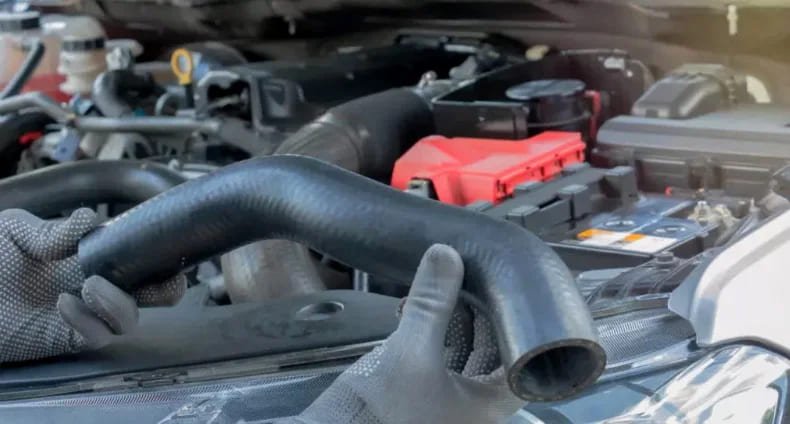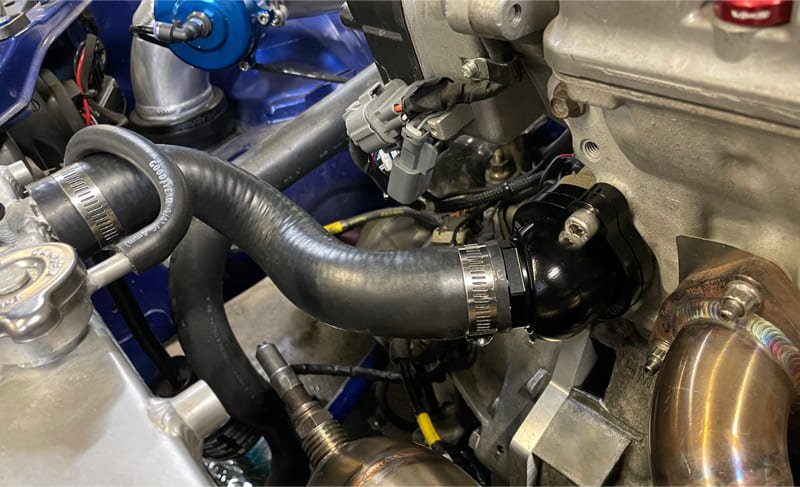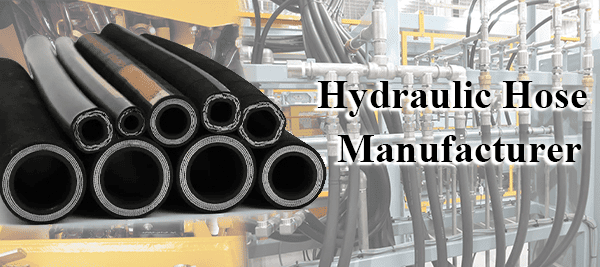Picture yourself driving on a hot summer day. Everything seems fine until steam starts pouring out from under the hood. You pull over, pop the hood, and see that the radiator hose has burst, spraying coolant all over the engine. This is a nightmare for any driver, and it can happen without warning. What made the hose burst? Could it have been prevented? Knowing why radiator hoses fail is essential to keeping this from happening and keeping your vehicle in top shape.
A radiator hose will burst due to either old age or pressure in the cooling system. Over time, hoses deteriorate, becoming brittle and weak. In other cases, high pressure from a thermostat that isn’t working or a head gasket failure can cause the cooling system to be overpressurized, causing the hose to burst.

Now, let’s take a deeper look at the common problems of car radiator hoses
What Causes Radiator Hoses to Burst?

Aging and Wear
Radiator hoses break down over time because of the extreme conditions they work under. The heat, coolant, and pressure they are constantly exposed to break down the rubber material, causing cracks and brittleness. As hoses age, they become less flexible and more likely to fail under normal operating conditions.
Overheating
An engine that’s too hot can cause hoses to soften, weaken, or swell. Prolonged overheating over time can increase pressure inside the cooling system, potentially rupturing already worn hoses.
Excessive Pressure
When the engine’s cooling system is over-pressurized, hoses weaken. A faulty radiator cap may not regulate the pressure, causing it to build up. When the pressure exceeds what the hose can handle, the hose can suddenly burst.
Using Low-Quality Coolant
Using low-quality coolant or not changing it for extended periods can corrode the inner wall of rubber hoses, causing them to become thin and brittle. Coolant containing impurities and rust increases the risk of hose wear and clogging.
Improper Installation or Damaged
Hoses that are not installed properly or have clamps that are not properly tightened can also burst. If a clamp is loose or not lined up properly, coolant can leak or not build up enough pressure to keep the system sealed, causing the hose to burst at its weakest point.
Other Physical Factors
Excessive heat and prolonged exposure to sunlight accelerate the aging of rubber. Chemicals (oil, fuel) splashed onto the hose surface can corrode the rubber.
How to Determine Whether the Radiator Hose is Damaged?
Visible Cracks or Bulges
Check the hoses for any visible cracks, splits, or bulges, especially at the bends. If you see a bulging hose, that means the internal layers are separating, and it’s about to fail.
Leaking Coolant
Look at the hoses. Are there any visible cracks, splits, or bulges? Pay particular attention to the bends in the hoses. If you see a bulging hose, that means the layers inside are separating and it’s about to fail.
Soft or Spongy Texture
Give the hoses a squeeze to see if they’re still in good shape. A good hose should be firm but flexible. If it feels soft, spongy, or overly rigid, the inside may deteriorate and the hose could blow out.
Overheating Engine
If you have a busted radiator hose, it can mess with the flow of coolant and cause your engine to overheat. If you see your temperature gauge climbing faster than normal, it could mean your hose is damaged and not letting coolant flow through it.
Prevention and Maintenance of Radiator Hoses

1. Regular Inspections
Inspect radiator hoses regularly for wear, recommended every six months or every 10,000 kilometers.
Focus on checking for cracks, bulges, hardening, leakage, or signs of wear. Early detection of these issues can help prevent sudden radiator hose failure.
Inspection Methods
- Visual Inspection: Check for cracks, bulges, hardening, or discoloration.
- Touch Inspection: Check if the hose is too rigid or too flexible.
- Connection Location: Check for loose clamps and leaks.
- Check if the coolant level drops frequently. If it drops too quickly, check the hose for leaks.
2. Replace Hoses Periodically
It is recommended to replace hoses every four to five years or after approximately 80,000 kilometers. Even if the hose appears fine, it should be replaced if it is aged and hardened.
3. Choosing the Right Hoses
Use radiator hoses that match your vehicle’s specifications. Choose high-quality radiator hoses and avoid inferior products.

4. Using the Correct Coolant
Using the wrong type of coolant or failing to change it regularly can lead to deposits and corrosion. Prevention: Use the manufacturer’s recommended coolant and flush the cooling system regularly.
5. Avoid Corrosion
Avoid spills of oil, fuel, or other chemicals on the hoses. Keep the engine compartment clean to minimize damage from dust and debris.
6. Ensure Proper Coolant Levels and Quality
Using the right kind of coolant for your vehicle is important to prevent damage to the hoses. Also, be sure to check and maintain your coolant levels regularly. You don’t want air in your system, which can cause it to overheat or build up too much pressure.
7. Proper Installation
When you install new hoses, make sure you put them on correctly and tighten the clamps properly. If a clamp is loose or a hose isn’t fitted right, you can get a leak, lose pressure, or have a hose blow off under pressure.
8. Monitor Engine Temperature
Regularly monitoring your engine’s temperature is a good way to catch cooling system problems early. If the temperature starts to go up unexpectedly, stop the vehicle and check the hoses for signs of failure.
How to Fix a Burst Radiator Hose
A burst radiator hose is a common vehicle malfunction. If not addressed promptly, it can cause serious engine damage. Below are emergency and complete solutions:
Stop the vehicle immediately.
If the water temperature gauge rises abnormally, white smoke comes out of the engine, or you smell coolant, pull over immediately and safely to the side of the road.
Turn off the engine and cool it down.
Turn off the engine and wait at least 15–30 minutes. Do not open the radiator cap while the vehicle is hot to avoid burns from hot coolant and steam.
Temporary Repair
If the crack is small, you can bandage it with heat-resistant tape, cable ties, cloth strips, or emergency repair adhesive to minimize coolant leakage.
Refill with coolant or clean water
After the temperature drops, open the radiator and refill with coolant. (If there is no coolant, you can temporarily add clean water, but this is only an emergency measure.)
Drive at a low speed to a repair shop.
After a temporary repair, drive only short distances and at a low speed to a repair shop for a complete radiator hose replacement.
Conclusion
Knowing the causes of a blown radiator hose and inspecting it regularly can help prevent sudden roadside failures. Regular maintenance and replacing the hoses when necessary will keep your vehicle in good running condition.



